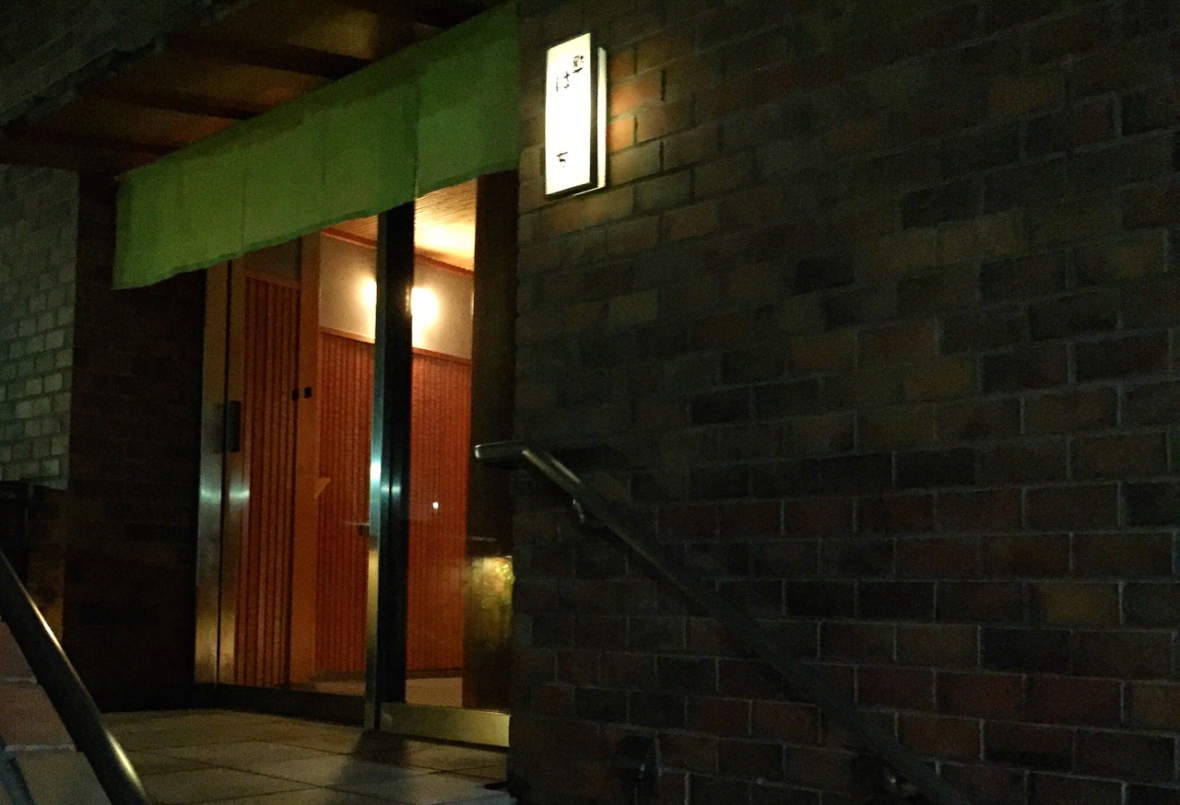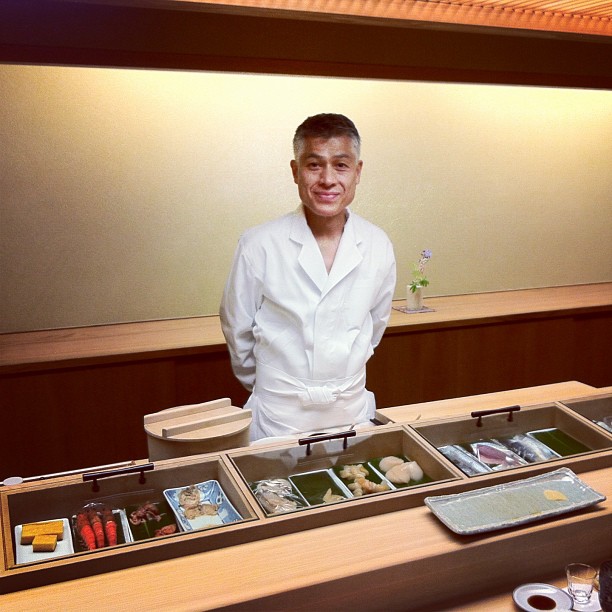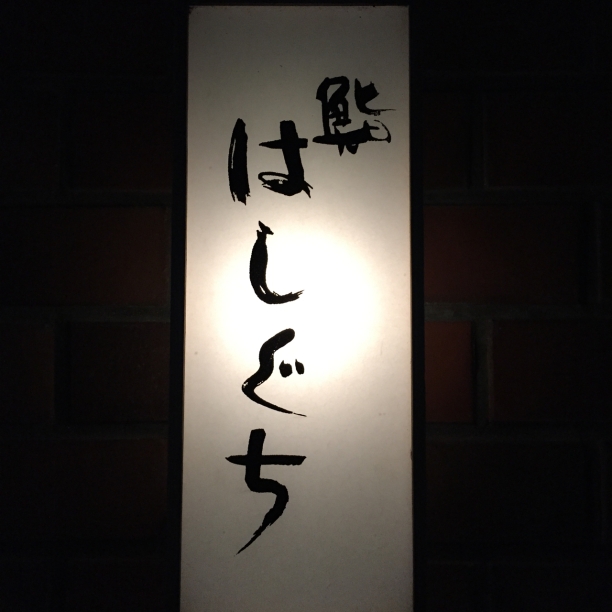16/20 
 8.5 |
8.5 |  3 |
3 |  3 |
3 |  1.5
1.5
Thumbs up
- Some of the best sushi one can eat in this world
- Watching Itamae Hashiguchi is an experience in itself
- Interior embodies the simplistic Japanese design aesthetic
- The most diverse range of seafood of any sushiya in Tokyo
Thumbs down
- No photography
- Nigiri is light and minimally seasoned, so it may not be everyone’s favourite
Recommended dish(es)
Omakase only (chef’s selection). Notable pieces include –
- Anago Nigiri
- Chutoro Nigiri
- Otoro Nigiri
TL;DR – Everyone will have their own favourite high end sushiya in Japan. But no one will argue that Hashiguchi has some of the best sushi in the world.
You would never guess that some of the world’s best sushi awaits inside.
So what was I doing eating $300 sushi, sitting in almost dead silence, in the middle of a seemingly dead suburban neighbourhood?
Well this story starts just a couple of months earlier. Once the decision was made to eat our way through Japan, we knew we had to seek the best sushi in the world. Having watched Jiro Dreams of Sushi multiple times, we knew exactly where to go. But being one of the hardest reservations to secure, the dates we wanted were booked out in less than a day.
To our surprise, Sukiyabashi Jiro wasn’t in the top 100 restaurants in Tokyo. Hell, it wasn’t even in the top 20 sushiyas in Tokyo.
Devastated, we consulted Tabelog, the local gospel for restaurants in Japan (much more reliable than the Michelin Guide, Tripadvisor or Yelp). To our surprise, Sukiyabashi Jiro wasn’t in the top 100 restaurants in Tokyo. Hell, it wasn’t even in the top 20 sushiyas in Tokyo. What was number 1? Sushi Saito, followed closely by Hashiguchi.
So here I was at the #2 sushiya in Tokyo, sitting in almost complete awe, in the middle of a quiet but friendly suburban neighbourhood.
Before arriving though, I had done hours (ok maybe minutes) of research on Hashiguchi. What fascinated me was the lack of information on this humble enigma of a sushiya. From what I could find though, I learnt that Hashiguchi is super anti-establishment, refuses Michelin Stars, and does not allow photography.
Soup Nazi Itamae Hashiguchi. Photo credit – @rliusd
I was expecting almost a Seinfeld-esque Soup Nazi.
So when I arrived, I was expecting almost a Seinfeld-esque Soup Nazi. But to my surprise, Itamae Hashiguchi was the most generous and gentle soul (until I asked if I could take photos). But I’m thankful he said no, as it allowed me to focus on the sushi and the artistic performance that was about to unfold.
And boy what a beautiful performance it was. Having been to multiple high end sushiyas, you discover that each Itamae has their own unique style. Itamae Hashiguchi’s movements were graceful yet purposeful, as if every move was meant to happen exactly when it happened. I simply cannot do it justice in words; it was indescribable.
Hashiguchi is famous for his unique “dancing sushi”…When the nigiri is placed in front of you, gravity compresses the fish against the rice, & the rice grains against themselves. During these split seconds, it appears as if your nigiri is dancing.
The sushi was as graceful as the performance. Itamae Hashiguchi is famous for his unique “dancing sushi”. He applies minimal pressure when making nigiri, resulting in air pockets being trapped amidst the shari and the neta “floating” on the shari. When the nigiri is placed in front of you, gravity compresses the neta (fish) against the shari (rice grains), and the rice grains against themselves. During these split seconds, it appears as if your nigiri is dancing. It was no fluke either, watching every single nigiri dance in front of us was surreal.
I often exaggerate and say things like Via Tokyo has ruined me for all other soft serves. But at the end of the day, soft serve is soft serve and if you put it in front of me, I’ll happily devour it.
But legitimately, Hashiguchi has virtually ruined me for all other non-high end sushi. Sokyo, widely accepted to be the best Japanese restaurant in Sydney – ruined. Sushi Dai, widely accepted to be the best sushi in the Tsukiji fish markets, which I had 2 days later – ruined. The moment I put the nigiri in my mouth, I would just become acutely aware of everything that was wrong with it; how imbalanced the neta to shari ratio was, how cold the neta was, how sticky the shari was. The moment you start tasting one element in your nigiri over another, is the moment your nigiri has failed; it should all taste like one harmonious piece.
What’s interesting, though, is that when I was eating Hashiguchi, my initial impression was that while it was very good, it was nothing life changing. Given all the expectation, I thought it would be an epiphany moment. At the time, little did I know, it would leave such lasting impression for all my sushi experiences to come.
I paid $300 for sushi, and all I got was this photo.
So here’s the only photo I took that night. But despite only having one photo, the memory of that night remains the strongest of all the meals I had in Japan.
For more personalised advice, customised food itineraries and to unlock your best culinary adventure, please contact me.
Hashiguchi (はしぐち)
1-5-20 Motoakasaka, Minato, Tokyo (map)
+81 3 3478-3588
Reservations only, book months ahead.



Wow… Given the price tag, it will be a while before I eat here but your point about balance hits home for me.
When I first ate sushi that was decent, it felt so because the topping and rice worked together. It was almost as if I had eaten ‘nothing’. If Hashiguchi is even beyond that…
Thanks for this post.
LikeLike
Thanks for reading!
Yeh Hashiguchi really is next level. Still amazed about the dancing sushi to this day. It is exxy, but completely worth it. I would recommend trying out the lunch options I mentioned in my Sushi Dai review. Lunch at these sushiyas tend to be quite a far bit cheaper.
Cheers,
Eric
LikeLike
I publish the following list http://www.opinionatedaboutdining.com/2016/japanese.html. I would like permission to use your photo of chef Hashiguchi
LikeLike
Hi Steve,
I love your list and the philosophy behind the list. I’ve been using it for a while now.
I’d be honoured for you to use my photos, if you credit the source 🙂
Cheers,
Eric
LikeLike
Nice blog, I’ve been following for a while. your take on Hashiguchi is interesting and I wonder if your perspective changes more with time.
My impression of Hashiguchi was that their Neta was a standout, both diverse and impeccable in quality. I personally felt the wasabi was a bit heavy handed (although not as much as some other places) and the shari too light on the vinegar (although this is personal preference).
Overall the experience was great and the best nigirizushi have had. I query whether places like Saito and Sugita, which are now virtually impossible to get a booking, are any ‘better’ – although I have not had the pleasure.
My latest trip to Japan has led me to believe really that the gem’s are in smaller cities. Places like Sapporo, Otaru, Kanazawa are real gems for finding sushi that are as good as Tokyo’s but without the price tag and the hordes of tourists. That’s just my two cents.
LikeLike
Welcome back. I remember our discussion in LuMi 😊
I originally dined at Hashiguchi about 4 years ago, and my thoughts haven’t changed since. Shari was definitely on the lighter side by design, and I don’t mind it. While I generally prefer stronger sharis, given the lightness is the way he shapes the nigiri, a light shari is better. I’ve actually come to appreciate it as I eat at more and more different sushiyas. At the end of the day, at the that high end, they are all almost equally as good just with slight differences in style (shari, neta aging etc)
Definitely agree that there are many gems at the other smaller cities, though if I have to compare the average high end sushiya, Tokyo would still have them beat. One of my favourite sushiyas is actually Taheizushi in Kanazawa. I still dream about his kagani crab and monkfish nigiri. The best monkfish I’ve ever had 🤤
LikeLike
Hi there,
Hashiguchi is a place we’ve been interested in for a very long time.
However, given that we will only be able to eat ~3 sushi meals in Tokyo, and that we haven’t really dived into the sushi scene there, do you think we will be able to appreciate the minimalism, intricacies, and overall level of nigiri served here? Or might we be better off visiting other locations where the rice is more strongly seasoned (and where overall flavors are more pronounced?) Also, we understand that “lightly flavored” is quite a relative term, since it seems most high-end sushi-ya that we visit outside of Japan season their rice very mildly, but the rice there wouldn’t be classified as “lightly flavored.” So would the flavor of rice at Hashiguchi be comparable to such establishments (as opposed to being “bland”/”tasteless”)?
Thank you very much 🙂
LikeLiked by 1 person
Hi Pachimari,
First of all, thank you for reading.
I don’t think it will necessarily be a wasted to have Hashiguchi as your first high end sushi meal in Tokyo. After all, it was my first high end sushi meal! I definitely didn’t appreciate all the intricacies, but I have grown to appreciate it more over time as I developed my sushi palate/experience. I’m definitely very thankful that I had the opportunity to even eat there as my first high end sushi meal, and don’t regret it at all.
Having said that, I more optimal strategy would probably be to have it in your first trip, but leave it as the last of your 3 sushi meals. You’ll get the best of both worlds. I’ll also advise exploring different styles of sushiyas so you can find the style that suits you. Some styles to consider include komezu vs aka vs blend (vinegar), shari strength (mild vs strong), fish ageing, otsumami vs nigiri focus, casual vs temple atmosphere, drink pairing styles (sake, wine, tea).
Hashiguchi is mildly flavoured, but not bland by any means. The important distinction is balance. The best way to describe it is with a symphony –
– Bland rice overseas: When a symphony is obviously missing an instrument that isn’t playing and is sticking out like a sore thumb
– Hashiguchi: The supporting instruments are playing in the background to enhance the key instrumentals but not competing with it
– More heavily seasoned rice: When several instruments play with equal volume to complement each other, becoming the key instrumentals themselves
Hope this helps rather than confuses haha.
Eric
LikeLike
Hi, can I enquire whether I can just call to make a reservation? Or reservation can only be made by a concierge?
And do they take English reservations? Because I don’t speak Japanese.
LikeLiked by 1 person
Hi Lau. They take English reservations but only though concierge 😊
LikeLike
Hi Eric,
You may remember me… I asked you a million questions about Umi, harutaka etc.
I just thought I would let you know that I managed to get a reservation at Hashiguchi! And I am also now after Namba (the new branch).
Would you say i have made a good choice, or would you swap Namba for something else?
Thanks!
Jacjk
LikeLike
Hi Jack,
Sorry for the delayed reply, been travelling.
Definitely a good choice. Namba is good.
Report back to let me know your thoughts after you go!
Cheers,
Eric
LikeLike
Yo,
How many months in advance do you have to book Hashiguchi?
LikeLiked by 1 person
Hey Ryan! I would recommend atleast 3 months in advance
LikeLike